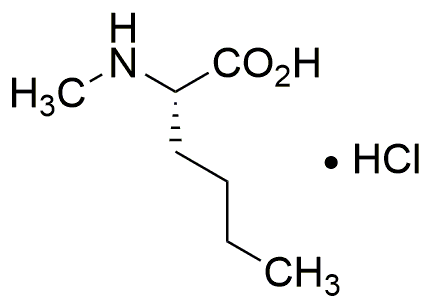N-Me-L-norleucine hydrochloride is widely utilized in research focused on
- Peptide Synthesis: This compound serves as a valuable building block in the synthesis of peptides, particularly in the development of novel therapeutic agents. Its unique structure allows for the introduction of specific functionalities that can enhance the biological activity of peptides.
- Drug Development: In pharmaceutical research, it is used to modify existing drugs to improve their efficacy and reduce side effects. Researchers can leverage its properties to create more effective treatments for various conditions.
- Biochemical Studies: It plays a crucial role in studying protein interactions and enzyme functions. By incorporating this compound into experimental designs, scientists can gain insights into metabolic pathways and regulatory mechanisms.
- Food Industry: The compound is explored for its potential applications in food science, particularly in the development of flavor enhancers or nutritional supplements, providing a means to improve food quality and health benefits.
- Cosmetic Formulations: Its properties are also being investigated in the cosmetic industry, where it can be used to enhance skin formulations, offering moisturizing and anti-aging benefits.
General Information
Properties
Safety and Regulations
Applications
N-Me-L-norleucine hydrochloride is widely utilized in research focused on
- Peptide Synthesis: This compound serves as a valuable building block in the synthesis of peptides, particularly in the development of novel therapeutic agents. Its unique structure allows for the introduction of specific functionalities that can enhance the biological activity of peptides.
- Drug Development: In pharmaceutical research, it is used to modify existing drugs to improve their efficacy and reduce side effects. Researchers can leverage its properties to create more effective treatments for various conditions.
- Biochemical Studies: It plays a crucial role in studying protein interactions and enzyme functions. By incorporating this compound into experimental designs, scientists can gain insights into metabolic pathways and regulatory mechanisms.
- Food Industry: The compound is explored for its potential applications in food science, particularly in the development of flavor enhancers or nutritional supplements, providing a means to improve food quality and health benefits.
- Cosmetic Formulations: Its properties are also being investigated in the cosmetic industry, where it can be used to enhance skin formulations, offering moisturizing and anti-aging benefits.
Documents
Safety Data Sheets (SDS)
The SDS provides comprehensive safety information on handling, storage, and disposal of the product.
Product Specification (PS)
The PS provides a comprehensive breakdown of the product’s properties, including chemical composition, physical state, purity, and storage requirements. It also details acceptable quality ranges and the product's intended applications.
Certificates of Analysis (COA)
Search for Certificates of Analysis (COA) by entering the products Lot Number. Lot and Batch Numbers can be found on a product’s label following the words ‘Lot’ or ‘Batch’.
*Catalog Number
*Lot Number
Certificates Of Origin (COO)
This COO confirms the country where the product was manufactured, and also details the materials and components used in it and whether it is derived from natural, synthetic, or other specific sources. This certificate may be required for customs, trade, and regulatory compliance.
*Catalog Number
*Lot Number
Safety Data Sheets (SDS)
The SDS provides comprehensive safety information on handling, storage, and disposal of the product.
DownloadProduct Specification (PS)
The PS provides a comprehensive breakdown of the product’s properties, including chemical composition, physical state, purity, and storage requirements. It also details acceptable quality ranges and the product's intended applications.
DownloadCertificates of Analysis (COA)
Search for Certificates of Analysis (COA) by entering the products Lot Number. Lot and Batch Numbers can be found on a product’s label following the words ‘Lot’ or ‘Batch’.
*Catalog Number
*Lot Number
Certificates Of Origin (COO)
This COO confirms the country where the product was manufactured, and also details the materials and components used in it and whether it is derived from natural, synthetic, or other specific sources. This certificate may be required for customs, trade, and regulatory compliance.


